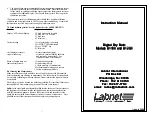
Principles of Access-T Alarm Reporting
Access-T supports three types of alarm dialout reporting methods:
•
Terminal Interface Alert Messages.
•
UnsolicitedTABS Messages.
•
SNMP Traps.
The following sections describe each of these reporting methods. Refer to
Chapter 6 for instructions on enabling an alarm reporting method via the Terminal
Interface.
Terminal Interface Alert Messages
Access-T can be configured to dial out to report alarms via the Supervisory Port.
When a user-specified alarm occurs, Access-T dials to connect with the terminal
and transmits a one-line
ALERT
banner. The
ALERT
banner includes the date,
time, system name, TABS address, serial number, and alert message, as
follows:
*_* 03/29/94 16:12:45 Access-T:Name (ADD:01, SN:000267) IS IN ALERT *_*
The following conditions apply to alarm dialout:
•
INTERFACE
must be set to
MODEM
.
•
Dialout occurs only for alarm types specified by the user.
•
Access-T dials out only if DCD is inactive (no connection).
•
Access-T automatically disconnects a dialout connection after a user-
specified period of inactivity. (This feature can be disabled.)
•
Clearing the alarm history cancels dialout for alarms in the cleared
report.
•
If an outstanding alarm is not cleared and the connection is termi-
nated abruptly without the alarm being cleared, Access-T will imme-
diately dial out to report the alarm. If connection is terminated due to
inactivity timeout, Access-T will wait a user-specified “backoff” period
before attempting to dial out again.
Dialout parameters (including wait-for-connect, inactivity, and backoff times)
are specified using the Set Modem Dialout command described in Chapter 6.
Special alarm dialout conditions arise when Access-T is used as a master.
Chapter 7
ACST-0351-005
Alarms, Reports, and Tests
June 1996
7-2
















































